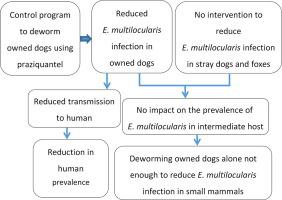International Journal for Parasitology ( IF 3.7 ) Pub Date : 2020-11-19 , DOI: 10.1016/j.ijpara.2020.08.010 Qian Wang 1 , Bo Zhong 1 , Wenjie Yu 1 , Guangjia Zhang 1 , Christine M Budke 2 , Sha Liao 1 , Wei He 1 , Fan Chen 1 , Kejun Xu 3 , Fei Xie 4 , Danbazeli 3 , Qi Wang 1 , Liu Yang 1 , Yan Huang 1 , Ruirui Li 1 , Renxing Yao 1 , Patrick Giraudoux 5 , Philip S Craig 6

|
Human alveolar echinococcosis (AE) is considered a neglected zoonotic disease by the World Health Organization (WHO). The causative pathogen, Echinococcus multilocularis, lives as an adult tapeworm in the intestinal tract of canines. AE was identified as an emerging public health issue in Tibetan communities of Shiqu County 20 years ago. On St. Lawrence Island, Alaska (USA), in the 1980s peri-domestic transmission of E. multilocularis was controlled by regular deworming of owned dogs over a 10-year period. In Tibetan communities, on the Tibetan Plateau, control of E. multilocularis transmission is challenging due to the continental setting, complex epidemiology, disease ecology, geography, and socio-cultural factors. However, a control programme based on deworming owned dogs using praziquental (PZQ) has been carried out since 2006. Assessment was conducted in townships where baseline data were available 10 years prior. Purging of dogs by oral administration of arecoline was used to measure E. multilocularis prevalence, trapping small mammals around communities was employed to assess the change in infection of pikas and voles, and analysis of human AE abdominal ultrasound-based data was used to understand the change in prevalence in the past decade. In all three evaluated townships, the E. multilocularis prevalence in owned dogs was significantly (P < 0.01) reduced from 7.23% (25/346) during 2000–2003 to 0.55% (1/181) in 2016. Human AE ultrasound-based prevalence (adjusted for age and sex) in five evaluated townships decreased significantly (P < 0.01) from 6.25% (200/3,198) during 2000–2002 to 3.67% (706/19,247) during 2015–2017. The 2016 prevalence of E. multilocularis metacestodes in small mammal intermediate hosts was not significantly different from the prevalence in 2008. The control programme was effective in reducing E. multilocularis infection in owned dogs and human AE prevalence, but did not significantly impact infection in wildlife intermediate hosts.











































 京公网安备 11010802027423号
京公网安备 11010802027423号